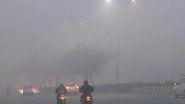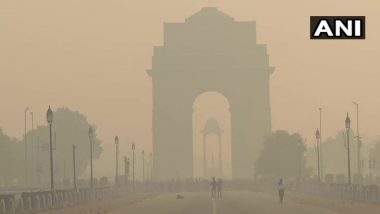New Delhi, Nov 12: The Ministry of Earth Sciences on Thursday claimed that the level of PM2.5, a deadly pollutant, is likely to be lowest in the past four years under zero-firecracker scenarios during Diwali.
On November 9, the National Green Tribunal had imposed a blanket ban on sale or use of all kinds of firecrackers in the National Capital Region till November 30. The direction also applies to cities and towns where air quality during November fell to 'poor' and above categories. Delhi Firecracker Ban: Gopal Rai Warns of Action Under Air Act Against Violators.
In 2019, however, even though the Delhi Government had organized four days of laser shows to convince the residents to choose life over firecrackers, the morning after Diwali, the city's air quality had turned worse than 2018.
With the spike in air pollution in Delhi-NCR, the Central Pollution Control Board (CPCB) has ordered closing of hot mix plants and stone crushers till November 17 and also asked Punjab and Haryana to take stringent actions to curb stubble burning.
Meanwhile, Delhi's air quality index stood at 318 micrograms per cubic meter at noon, as against 476 on Tuesday. "Thanks to the winds from East, Delhi pollution has reduced. The AQI of most places is now less than 400. Many areas are less than 300," said Mahesh Palawat, from private weather forecasting agency Skymet Weather.
He added, "Easterly winds are blocking the smoke from stubble burning. Waiting for rain on November 15," said Palawat.
The improvement of air quality will be short lived. According to the Air Quality Early Warning System for Delhi, under the aegis of the ministry, the air quality is likely to deteriorate marginally at night. It may deteriorate further but remain in a very poor category on November 13 and 14, the day Diwali will be celebrated.
"Under zero firecracker scenarios, the level of PM2.5 is likely to be the lowest in the past four years as not so calm surface winds in Delhi will help in dispersion," the ministry said. However, stubble burning-induced impact on AQI is expected to increase from negligible to moderate for the next two days.
There will be a spike in PM2.5 in the wee hours of November 15 due to fire-related emissions, it added. "The biomass plume transport-level winds are now north-westerly and will have high potential to transport biomass plume in the next three days but the expected moderate surface winds in Delhi will not allow rapid accumulation of pollutants for a longer period."
The ministry further stated, "The moderate easterly boundary layer winds are likely on 15th and 16th November. Isolated rainfall under the influence of fresh western disturbance by 16th November is also expected."
These two factors will help in flushing out the impact of any additional emissions and biomass related impact to make AQI in the lower end of very poor by late November 16.
(The above story first appeared on LatestLY on Nov 12, 2020 03:33 PM IST. For more news and updates on politics, world, sports, entertainment and lifestyle, log on to our website latestly.com).













 Quickly
Quickly












